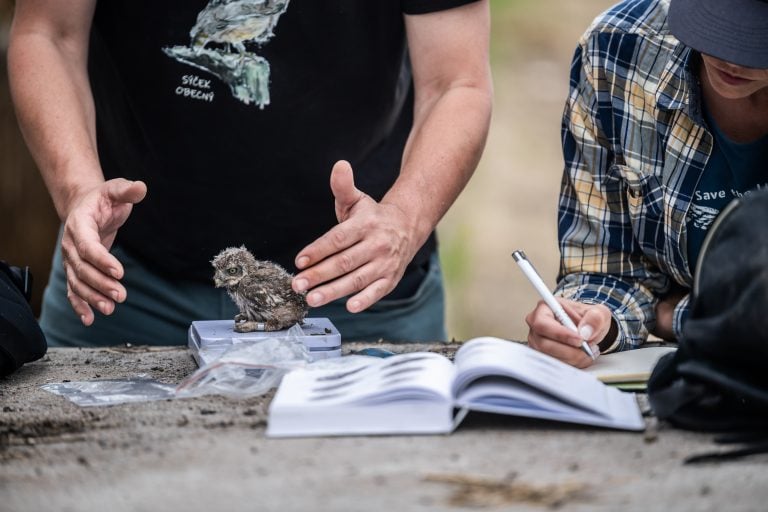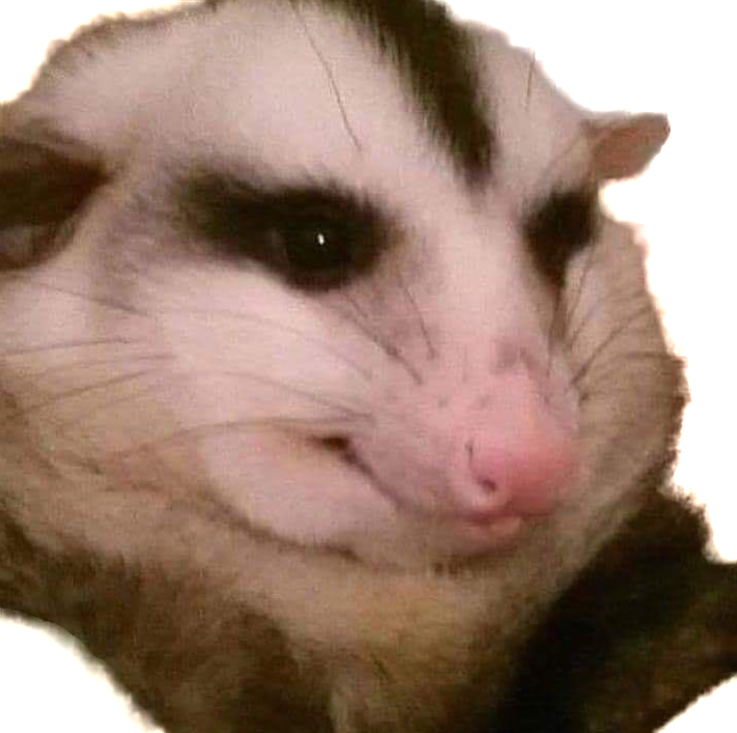Shamelessly stolen from mastodon post about protection efforts in Czech Republic.
I also love that handful of owl from the source post.
 @birdlifecz@mastodonczech.cz
@birdlifecz@mastodonczech.czAn owl in the hand is worth errr two in the guidebook?
golf clap
Made me think of the meme where the reporter matches the police sketch 😆
I went to go find that meme and found a “police sketch lolz” thread where this one seemed more to match the OP

I like this one. The one I was thinking of felt a bit too racist caricature for me to want to post the actual pic when I went to look it up, and other copycats just looked too goofy. This one seems to navigate the grey area nicely.
Yeah I thought so too - and I love how my brain is like "Oh c’mon, that doesn’t even . . . actually . . "
Lil homie looking like “How dare you, sir! Unhand me this instant!”
Never have I seen an owl more poised to erupt in a supernova of owly rage.
They are calm and easy to handle, according to the article in czech.
It’s not a book, it’s a collection of Wanted posters.
Original article is pretty good. Here is a quick translation:
Czech Society for Ornithology
Little owls have raised over 70 young in northern Bohemia this year. Farmers have also joined the protection Tereza Valchářová / 11.9.2024 / Little Owl, Press releases
Despite the unfavourable natural conditions during the spring, this year’s monitoring of Little Owls brought positive results. The population of little owls in the core area of northwest Bohemia remains at a similar level as last year. According to data obtained by ornithologists from the Czech Society for Ornithology (CSO) and the Institute of Vertebrate Biology of the Czech Academy of Sciences (IVB CAS), little owls have occupied almost sixty territories and raised at least 71 young. Ornithologists and farmers continue to carry out conservation activities aimed at increasing the population of this critically endangered owl. The decline of little owls is mainly due to intensive agriculture and the associated lack of food and nesting cavities, but also technical traps, in which little owls often die unnecessarily. Farmers and ornithologists help little owls by removing dangerous traps, installing nesting boxes and adjusting their farming appropriately.
This year, the little owls had to deal with a lack of food and unpredictable weather. “The common vole, the main prey of little owls, has seen a sharp decline in population in the monitored area. At the same time, the spring weather brought abnormal temperature fluctuations, when almost summer weather suddenly alternated with frosts. Fortunately, these adverse circumstances did not have a significantly negative impact on the owl population, unlike other owl species, of which we counted significantly fewer than last year,” says Martin Šálek, Little Owl Protection Coordinator from the CSO and the Institute of Owls of the CAS.
The population of little owls has not increased this year, but it has not decreased significantly either. “Of the total of 59 territories occupied, only the male was observed in 15, only the female in the other 8, and the remaining territories were occupied by 36 pairs, which gave birth to at least 71 young. This is a similar number to what we recorded last year. In any case, the population remains very fragile and so far we have not managed to reverse the population trend so that the number of little owls starts to increase significantly,” Šálek points out.
Little owls are using nesting boxes more and more than natural (and less safe) cavities. Photo: State Environmental Fund of the Czech Republic That is why ornithologists are trying to support little owls. One of the activities is hanging nest boxes secured against martens and cats. They hang the boxes almost exclusively in human settlements, especially on farms where little owls have moved from the open agricultural landscape. “An intensively managed landscape with large tracts of fields and no old hollow trees no longer offers the little owls suitable conditions for their natural nesting. Most little owls use the boxes we have installed. This year, a record 26 pairs nested in the boxes, the remaining pairs used other cavities and hiding places for nesting. We have not been able to trace the nesting site of some pairs, so it is clear that the real number of young will be even higher than the one we now know about,” explains Zuzana Kučerová, CSO field worker for the protection of little owls.
Farmers help protect the little owl Cooperation with farmers is essential for effective protection of little owls. Together with ornithologists, they hung 20 new nest boxes in early spring, some of which were occupied by little owls this year. In addition, farmers help with a number of other conservation activities. Among the most important are securing and removing potentially dangerous technical traps, such as water tanks, ventilation shafts, vertically standing pipes or hay blowers. Not only owls often die in them, but also other animals that cannot get out of there on their own. These unnecessary deaths can be prevented, for example, by placing floats in barrels and drinkers and securing chimneys, gutters or pipes.
“We also agree with farmers on a suitable way of farming around the nesting sites – for example, reducing the size of soil blocks, planting trees and shrubs, installing crutches or mosaic-like mowing of grassland,” adds Kučerová. It is the appropriate method of grassland treatment, creating a mosaic of areas with a diverse vegetation structure, that can significantly help little owls. Therefore, this year, ornithologists have published a handbook for land owners, gardeners, municipalities or farmers with tips on how to appropriately care for grasslands with regard to their natural and species diversity. Proper maintenance of these stands can help not only little owls, but also a wide range of other animals and plants.
The handbook can be downloaded here or on the https://www.birdlife.cz/sycek-obecny/ page.
Supplementary feeding increases the chances of survival of the young Just like last year, ornithologists have started to support the little owls in some places. “We have recorded less food in the monitored area this year, so we wanted to support the little owls so that they have a better chance of raising their young. We offered dead mice to a total of fifteen pairs on a mat near the nest box during the nesting period,” says Kučerová. “However, the additionally fed mice are only a supplement to the diet of little owls, who always try to get their natural food. However, if we want to increase the population of the little owl, supplementary feeding is a suitable form to support the good condition of not only the parents, but also the young, which thus have a better chance of survival,” emphasizes Šálek and adds: “However, it is essential to try to ensure that the little owls have enough of their natural prey in the landscape. However, this is currently unrealistic due to the fact that in the Czech Republic, a large amount of chemicals and plant protection products are mostly farmed intensively. We are therefore very happy that friendly farmers support the little owls.”
Farmers like to get involved in the protection of little owls. Photo: State Environmental Fund of the Czech Republic Even the farmers themselves are happy to contribute to the protection of little owls. “I am very happy for the cooperation with the CSO. I appreciate their work and I think that any meaningful form of landscape and nature protection by humans is necessary. We farmers are willy-nilly very intertwined with nature and we influence it very much, so it is necessary to return the debt in any way. I am very pleased that “our” little owls managed to breed 5 young and that we could make it a little easier for them,” says farmer Lucie Čtrnáctá.
It wouldn’t be possible without research Research is key to effectively setting up rescue measures. “Important activities include ringing and recording the voices of little owls, thanks to which we are able to monitor the movement of specific little owls and the stability of nesting areas. Continuous monitoring of genetic variability is also important to find out what effect inbreeding has on a small owl population. Genetic tests can also be used to deduce whether individuals fly over longer distances or what is the degree of kinship between individuals within subpopulations. Comprehensive data on the occurrence and nesting biology of Little Owls across the country can only be obtained thanks to the cooperation of a number of colleagues and volunteers. They deserve a big thank you for their field commitment,” adds Šálek.
We also thank all cooperating farmers and supporters.
The translation pointed out “technical traps,” which is probably an odd translation. I looked up the article that was referenced, but I don’t recommend you look at it, as it shows dead owls a number of times. If you do want to see it, it’s here. It’s essentially referring to manmade objects that pose a danger to owls due to their desire to go into holes. Water barrels, pipes, vent shafts, and also things like sports netting or other hanging nets. Many of these objects have vertical sides made of very smooth material like metal or plastic, and they have nothing to grip on to climb out and will starve, become injured, or drown. The article mentions one single hay machine that contained 28 dead barn owls. Usually it is not difficult to secure these items to make sure animals can’t get in, we just need to be sure people are aware that it’s a problem.
Also, this cute pic has not been shared yet!

I am native speaker and I also didn’t understand it until it was explained later in the article.
I think that better term would be technological trap - unintentionally made trap using bad technology.
It is really shocking the things we don’t think of that can trap an animal due to their anatomies being so different to ours.
In our neighborhood, the drains from the roof gutters go to some underground pipe network, and twice the one summer I got 2 birds out of them before they died or fell too deep.
I had been hearing a scratching sound next to my patio and knew something was inside, but I had no clue what it was. I disconnected the pipe, and a birds face popped out and then it shot off into the woods as fast as it could.
A month or so later, I saw a neighbor looking at their pipe in a confused manner and I heard the same sound and got that one out.
I’ve pulled a few frogs out of the storm drain too before they got swept away or sun baked.
We do a good job making most things human proof nowadays, but we could do a little more to keep the animals safe yet as well.
Identifying Owls with simple tools
“Yep, it’s an owl”
That’s the face of a lad who’s been GOT
Does it say superb under my picture? It does doesn’t it?
How do you catch an owl like that? Just reach up into a tree and grab one? Seems risky…
Politely ask them to come down for identification and show them your forest ranger badge.
Usually they’ll catch birds for surveys with thin mist nets. But idk how to catch owls unless they caught him at nighttime haha
Ahhhh okay. So I take it they watch the nets quietly nearby so they can grab the birds before they struggle too much and injure themselves? So for owls you just need a lot of coffee!
Yes, they are checked very frequently. There is a ton of licensing and permitting required, so the researchers wish to steer clear of trouble. Mist nets are very regulated, as they are used for poaching as well.
They are sized for different animals, and the birds will be lured with a call into the net, where they bounce off and get caught in a pocket. They’re then retrieved and taken to a station to be measured and banded.
You can see my previous write up here, or there is this page all about mist nets.
“It says here you’re wanted for stalking and pellet littering.”
“What? I needed the money! Everybody’s doing it these days! You’re not the boss of me!”
Different beak than what’s shown on the page, so I am guessing flipping pages to find the right page may be a tad awkward
this is so cute it hurts a little
It’s like holding an ice cream cone.









